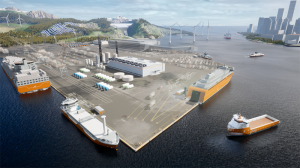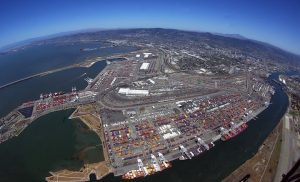By Leo Ryan, Editor
Containership congestions at unprecedented levels at the ports of Los Angeles and Long Beach, the biggest maritime complex in North America, cannot be rapidly alleviated due to the devastating impact of rising COVID-19 cases amongst longshoremen, truck drivers and freight train operators, Capt. Kip Louttit, Executive Director of the Marine Exchange of Southern California, told Maritime Magazine today.
“There are simply less people to handle a surge in cargo that began in the fall,” Capt. Louttit said, singling out the substantial demand for home improvement products and office equipment from pandemic-impacted American citizens.
He indicated that some 1,800 longshoremen out of 14,000 have up till now been hit by the pandemic and are no longer on the docks. “The same pattern is happening with truck drivers and the train operators, so there is a domino effect on the whole supply chain.” Compounding the gridlock are the social-distancing restrictions for working dockers and shortages of equipment to move the containers. Together, the ports of Los Angeles and Long Beach handle more than 17 million containers annually.
While authorities in the US are encouraging shipping lines to look at alternative gateways in the Pacific Northwest, Capt. Louttit said: “I have seen no diversions with the back-up so far to other US ports or even the ports of Vancouver and Prince Rupert so far.” Spare capacity, in any case, is reported to be limited at such ports as Oakland, Vancouver or Prince Rupert.
Today there are 48 ships – nearly all container vessels – at anchor, compared with 50 vessels awaiting berth on Tuesday. For the ships at anchor, the wait to proceed to berth can range between several days and nearly two weeks. Putting things in perspective, Capt. Louttit sounded a positive note. “There is good movement. We assign anchorages like a truck stop. It is all very carefully managed. It is not chaos, just a lot of ships.”

But the Port of Los Angeles is also now suffering box shortages, according to the Container Availability Index from Germany’s Container xChange. After struggling to cope with excess containers for much of 2020, the port is now scrambling to find available equipment.
Meanwhile, the American Association of Port Authorities (AAPA) has asked the U.S. Congress and the Biden administration to provide emergency relief funding for the country’s maritime transportation system. Joining with thirty-five (35) other maritime industry groups, AAPA sent a letter to Congressional leaders and President Biden highlighting this critical need. Outlining significant negative impacts to the maritime industry from the ongoing global pandemic, the groups stated that, “Despite container surges at several large ports, commercial cargo volumes have plummeted across the industry – total waterborne trade volume is down 5.5 percent compared to last year, while the value of this trade has crashed by 12.7 percent totaling US$200 billion.” (photos Marine Exchange of Southern California)





